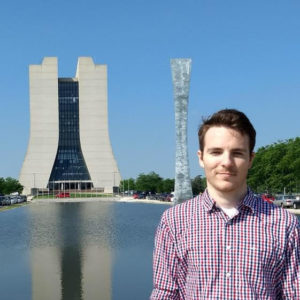 The universe is a complicated place, full of matter, antimatter and quirky subatomic particles. To help explain it, scientists have created the so-called Standard Model of particle physics. This approach helps describe how the basic building blocks of matter interact, and therefore, how the universe looks and functions. But while this model is currently the most accurate description of the subatomic world, it is far from complete.
The universe is a complicated place, full of matter, antimatter and quirky subatomic particles. To help explain it, scientists have created the so-called Standard Model of particle physics. This approach helps describe how the basic building blocks of matter interact, and therefore, how the universe looks and functions. But while this model is currently the most accurate description of the subatomic world, it is far from complete.
Physics graduate student Derek Doyle is attempting to fill in the gaps. He works on Fermilab’s NOvA experiment, an international physics collaboration working towards understanding neutrinos, nature’s most elusive particles.
“Neutrinos are very difficult to measure and do analyses on, so exploring complexities and overcoming experimental challenges is what really keeps me interested,” said Doyle.
HQ: CSU
Doyle is able to carry out his research remotely as well as monitor and operate the NOvA experiment at CSU’s NOvA Remote Operations Center (ROC), led by Associate Professor of Physics Norm Buchanan. “Norm is awesome,” said Doyle. “He is very interested in, dedicated to and excited about the work that NOvA and his students are doing, which makes working for him a great experience.”
Doyle’s work with NOvA is supported in part by the Scientific Discovery through Advanced Computing (SciDAC) program, a grant initiated by the U.S. Department of Energy in 2001 to bring together many of the nation’s top researchers to develop new methods for scientific discovery using high-performance computing. The program is currently in its fourth cycle (SciDAC-4), and is recognized as the leader in furthering the advancement of scientific computing.
“Because neutrinos are so elusive, we only measure a handful of them in our far detector, even after years of taking data,” said Doyle. “That, and other complications in the model require us to do highly computationally intensive statistical corrections in order to report our results to the physics community. In the past, this procedure had been the bottleneck of our results, taking four weeks to complete. The SciDAC-4 grant gave us the support needed to use the enormous high performance computers of the National Energy Research Scientific Computing Center (NERSC), which is enabling us to do these statistical corrections 50 times faster and with more precision. Under this grant, we are also able to develop tools adaptable to other analyses and researchers so that scientists around the world can benefit from these large scale systems.”
Doyle works alongside CSU Postdoctoral Fellow Steven Calvez to perform these statistical corrections. “Steven is a great addition to the team and a pleasure to work with,” said Doyle. “He brings expertise and a fresh outlook that is invaluable to the project, as well as a sense of humor that helps keeps tensions low during times of high stress.”
Doyle’s role in this project also includes collaborating with other NOvA members to further the analysis. “This is the first example of the SciDAC-4 group working directly with another collaboration, and the benefits were immediate,” said Doyle. “Not only was NOvA able to report fully corrected results at the Neutrino18 conference in Germany because of our work, but shortly after, NOvA also showed interest in adopting other methods developed by the SciDAC-4 group to deal with their large files and how they are used in machine learning.”
Just the beginning
His classes and teaching schedule keep him busy, but Doyle hasn’t slowed down. “I’m helping a few new postdocs on the project get up to speed with the work that we’ve done over the summer, writing my Master’s thesis on this work and starting on what will be my Ph.D. thesis project, the electron antineutrino cross section, and thinking about how we will use multi-universe modeling and NERSC in the analysis.”